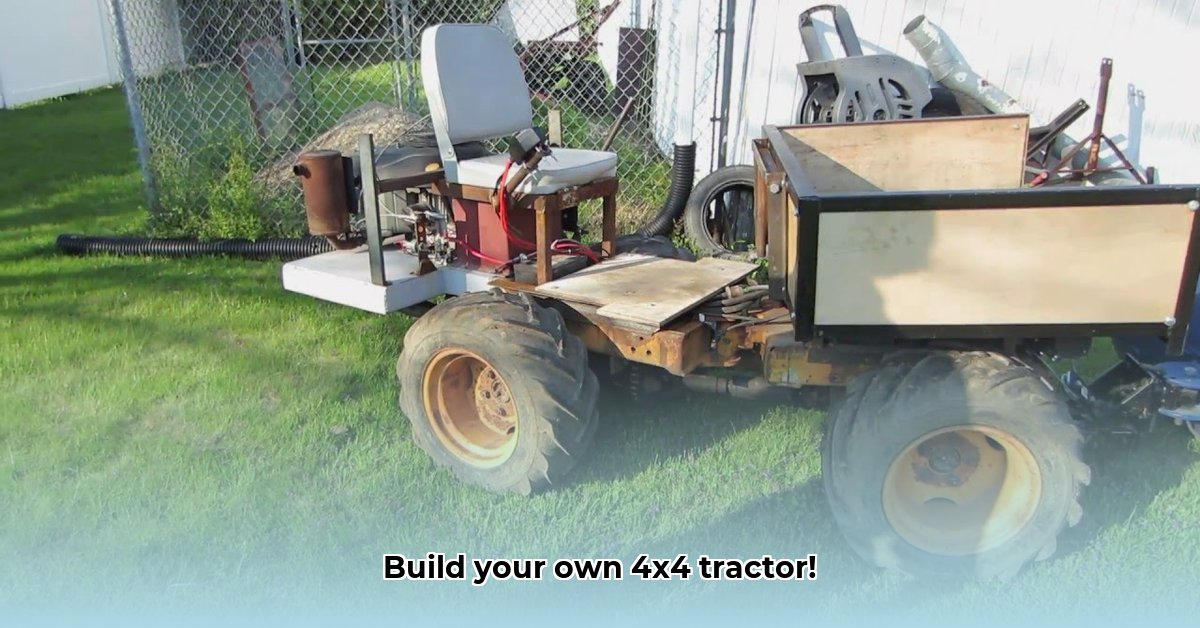
Homemade 4x4 Tractor Plans: Your Path to Sustainable and Economical Farming
Building your own four-wheel-drive tractor is a challenging yet rewarding project. This guide provides a comprehensive, step-by-step approach, emphasizing safety and cost-effectiveness, making this ambitious project achievable. We will explore the "why," "how," and the crucial "what ifs" to equip you for success. For more detailed plans, check out these 4x4 tractor plans.
Why Build Your Own Tractor? A Case for Sustainability and Savings
Why invest the time and effort in building a homemade tractor? The advantages are compelling for small-scale farmers and homesteaders.
- Cost Savings: Commercially available tractors can be prohibitively expensive. Building your own significantly reduces upfront costs, especially when sourcing used parts.
- Customization: A homemade tractor allows for precise tailoring to your specific needs and farm layout, optimizing efficiency and minimizing wasted resources.
- Sustainability: Using reclaimed or recycled materials minimizes your environmental footprint, aligning with sustainable farming practices. This empowers you to create a farming system that is less impactful and more efficient.
Aren't the potential cost savings of a homemade tractor significant? Dr. Anya Sharma, Agricultural Engineering Professor at the University of California, Davis, notes, "Many small-scale farmers find that building their own tractor is significantly more affordable than buying a commercial one." A well-planned build can save thousands of dollars compared to purchasing a similar machine.
Designing Your Tractor: Matching Design to Your Needs
Choosing the right design is paramount. Consider the size of your property, the tasks the tractor will perform, and your budget.
- Articulated Design: Offers superior maneuverability, ideal for navigating tight spaces and obstacles. However, it's typically more complex to build.
- Rigid Frame Design: Simpler to construct, offering a sturdy platform; however, it might lack the agility of an articulated design in challenging terrain.
What aspects of your farm's layout will most influence your design decisions? The key is understanding the specific demands of your property and activities.
Material Sourcing and Budget: A Realistic Cost Analysis
Sourcing materials is a crucial step. This section provides a transparent cost analysis, based on realistic pricing, to assist in budget planning.
| Component | Material Options | Estimated Cost (USD) | Notes |
|---|---|---|---|
| Engine | Used diesel engine | $500 - $2000 | Condition heavily impacts cost and reliability |
| Frame | Steel tubing, angle iron | $300 - $800 | Gauge and thickness determine strength |
| Axles | Salvaged, new | $200 - $1000+ | Source dictates price |
| Tires | Used agricultural tires | $100 - $500 per tire | Size and condition influence cost |
| Hydraulics (optional) | Used components or new components | $500 - $2000+ | The most complex and potentially costly item |
Remember, these are estimates. Actual costs will depend on your location, material choices, and potential unforeseen expenses. Thorough market research is highly recommended.
Safety First: Prioritizing Safety Throughout the Build
Safety is non-negotiable. Building a tractor involves working with heavy machinery and potentially hazardous materials.
- Rollover Protection Structure (ROPS): Absolutely essential for operator protection in case of a rollover.
- Emergency Shut-off Switch: A readily accessible switch is vital for immediate stopping in emergencies.
- Reliable Braking System: A dependable braking system is crucial for safe operation.
Failing to prioritize safety drastically increases the risk of serious accidents. Always consult relevant safety regulations and guidelines.
Step-by-Step Construction Guide (Simplified Overview)
While detailed plans are beyond this article's scope, this simplified overview provides a framework. Detailed diagrams and comprehensive plans are crucial for a successful build.
- Frame Construction: Precise measurements and welding skills are vital for a sturdy base.
- Engine Mounting: Securely attach the engine, ensuring proper alignment to minimize vibration.
- Axle Installation: Careful alignment of the axles is essential for proper operation and steering.
- Hydraulic System Installation (Optional): This complex step requires specialized knowledge; seek guidance if needed.
- Transmission Mounting: Securely mount the transmission to ensure smooth gear shifting and efficient power transfer.
- Wiring and Controls: Organize wiring systematically and install controls for easy access and operation.
- Testing and Refinement: Rigorous testing is critical before regular use, allowing for necessary adjustments.
Each of these steps necessitates careful planning and precision.
Troubleshooting and Maintenance: Ensuring Longevity
Regular maintenance is vital for your tractor's longevity.
- Preventative Maintenance: Scheduled maintenance keeps your tractor running smoothly and minimizes the risk of breakdowns.
- Troubleshooting: Be prepared to address unexpected issues. Having a toolbox of essential spare parts is recommended.
- Expert Advice: Don't hesitate to seek guidance from experienced mechanics or hobbyists.
Proactive maintenance and troubleshooting save time and money in the long run.
Calculating the Long-Term Cost-Effectiveness
Building your own tractor is an investment. Compare your total cost (materials, labor, and time) against the price of a comparable commercial tractor. Consider factors like depreciation, maintenance, and replacement parts. A well-planned build can result in significant long-term cost savings. Is your homemade tractor more cost effective than buying one commercially? The answer depends on careful cost analysis.
Conclusion: Embracing the Challenge of Sustainable Farming
Building your own 4x4 tractor is a significant undertaking. However, by carefully following this guide, emphasizing safety, and employing meticulous planning, this ambitious project becomes more achievable. The benefits of cost-savings, sustainability, and customization make it a worthwhile endeavor for those seeking a more self-sufficient and environmentally conscious approach to farming.